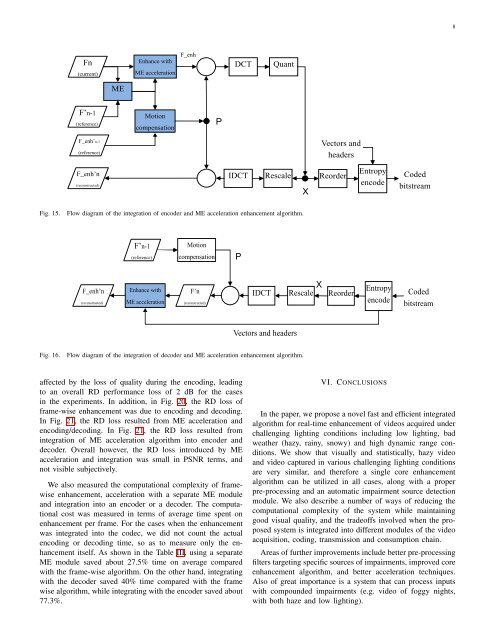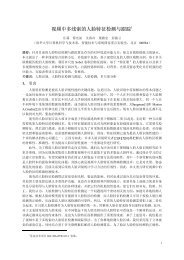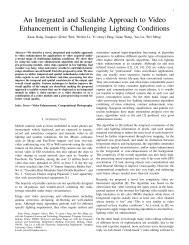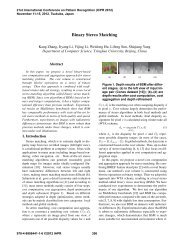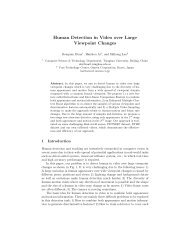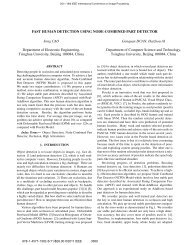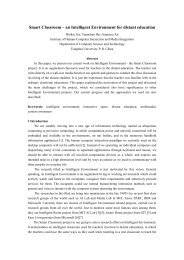An Efficient and Integrated Algorithm for Video Enhancement in ...
An Efficient and Integrated Algorithm for Video Enhancement in ...
An Efficient and Integrated Algorithm for Video Enhancement in ...
Create successful ePaper yourself
Turn your PDF publications into a flip-book with our unique Google optimized e-Paper software.
8<br />
Fn<br />
(current)<br />
Enhance with<br />
ME acceleration<br />
F_enh<br />
DCT<br />
Quant<br />
ME<br />
F’n-1<br />
(reference)<br />
Motion<br />
compensation<br />
P<br />
F_enh’n-1<br />
(reference)<br />
Vectors <strong>and</strong><br />
headers<br />
F_enh’n<br />
(reconstructed)<br />
IDCT<br />
Rescale<br />
X<br />
Reorder<br />
Entropy<br />
encode<br />
Coded<br />
bitstream<br />
Fig. 15.<br />
Flow diagram of the <strong>in</strong>tegration of encoder <strong>and</strong> ME acceleration enhancement algorithm.<br />
F’n-1<br />
(reference)<br />
Motion<br />
compensation<br />
P<br />
F_enh’n<br />
(reconstructed)<br />
Enhance with<br />
ME acceleration<br />
F’n<br />
(reconstructed)<br />
IDCT<br />
Rescale X<br />
Reorder<br />
Entropy<br />
encode<br />
Coded<br />
bitstream<br />
Vectors <strong>and</strong> headers<br />
Fig. 16.<br />
Flow diagram of the <strong>in</strong>tegration of decoder <strong>and</strong> ME acceleration enhancement algorithm.<br />
affected by the loss of quality dur<strong>in</strong>g the encod<strong>in</strong>g, lead<strong>in</strong>g<br />
to an overall RD per<strong>for</strong>mance loss of 2 dB <strong>for</strong> the cases<br />
<strong>in</strong> the experiments. In addition, <strong>in</strong> Fig. 20, the RD loss of<br />
frame-wise enhancement was due to encod<strong>in</strong>g <strong>and</strong> decod<strong>in</strong>g.<br />
In Fig. 21, the RD loss resulted from ME acceleration <strong>and</strong><br />
encod<strong>in</strong>g/decod<strong>in</strong>g. In Fig. 21, the RD loss resulted from<br />
<strong>in</strong>tegration of ME acceleration algorithm <strong>in</strong>to encoder <strong>and</strong><br />
decoder. Overall however, the RD loss <strong>in</strong>troduced by ME<br />
acceleration <strong>and</strong> <strong>in</strong>tegration was small <strong>in</strong> PSNR terms, <strong>and</strong><br />
not visible subjectively.<br />
We also measured the computational complexity of framewise<br />
enhancement, acceleration with a separate ME module<br />
<strong>and</strong> <strong>in</strong>tegration <strong>in</strong>to an encoder or a decoder. The computational<br />
cost was measured <strong>in</strong> terms of average time spent on<br />
enhancement per frame. For the cases when the enhancement<br />
was <strong>in</strong>tegrated <strong>in</strong>to the codec, we did not count the actual<br />
encod<strong>in</strong>g or decod<strong>in</strong>g time, so as to measure only the enhancement<br />
itself. As shown <strong>in</strong> the Table III, us<strong>in</strong>g a separate<br />
ME module saved about 27.5% time on average compared<br />
with the frame-wise algorithm. On the other h<strong>and</strong>, <strong>in</strong>tegrat<strong>in</strong>g<br />
with the decoder saved 40% time compared with the frame<br />
wise algorithm, while <strong>in</strong>tegrat<strong>in</strong>g with the encoder saved about<br />
77.3%.<br />
VI. CONCLUSIONS<br />
In the paper, we propose a novel fast <strong>and</strong> efficient <strong>in</strong>tegrated<br />
algorithm <strong>for</strong> real-time enhancement of videos acquired under<br />
challeng<strong>in</strong>g light<strong>in</strong>g conditions <strong>in</strong>clud<strong>in</strong>g low light<strong>in</strong>g, bad<br />
weather (hazy, ra<strong>in</strong>y, snowy) <strong>and</strong> high dynamic range conditions.<br />
We show that visually <strong>and</strong> statistically, hazy video<br />
<strong>and</strong> video captured <strong>in</strong> various challeng<strong>in</strong>g light<strong>in</strong>g conditions<br />
are very similar, <strong>and</strong> there<strong>for</strong>e a s<strong>in</strong>gle core enhancement<br />
algorithm can be utilized <strong>in</strong> all cases, along with a proper<br />
pre-process<strong>in</strong>g <strong>and</strong> an automatic impairment source detection<br />
module. We also describe a number of ways of reduc<strong>in</strong>g the<br />
computational complexity of the system while ma<strong>in</strong>ta<strong>in</strong><strong>in</strong>g<br />
good visual quality, <strong>and</strong> the tradeoffs <strong>in</strong>volved when the proposed<br />
system is <strong>in</strong>tegrated <strong>in</strong>to different modules of the video<br />
acquisition, cod<strong>in</strong>g, transmission <strong>and</strong> consumption cha<strong>in</strong>.<br />
Areas of further improvements <strong>in</strong>clude better pre-process<strong>in</strong>g<br />
filters target<strong>in</strong>g specific sources of impairments, improved core<br />
enhancement algorithm, <strong>and</strong> better acceleration techniques.<br />
Also of great importance is a system that can process <strong>in</strong>puts<br />
with compounded impairments (e.g. video of foggy nights,<br />
with both haze <strong>and</strong> low light<strong>in</strong>g).


